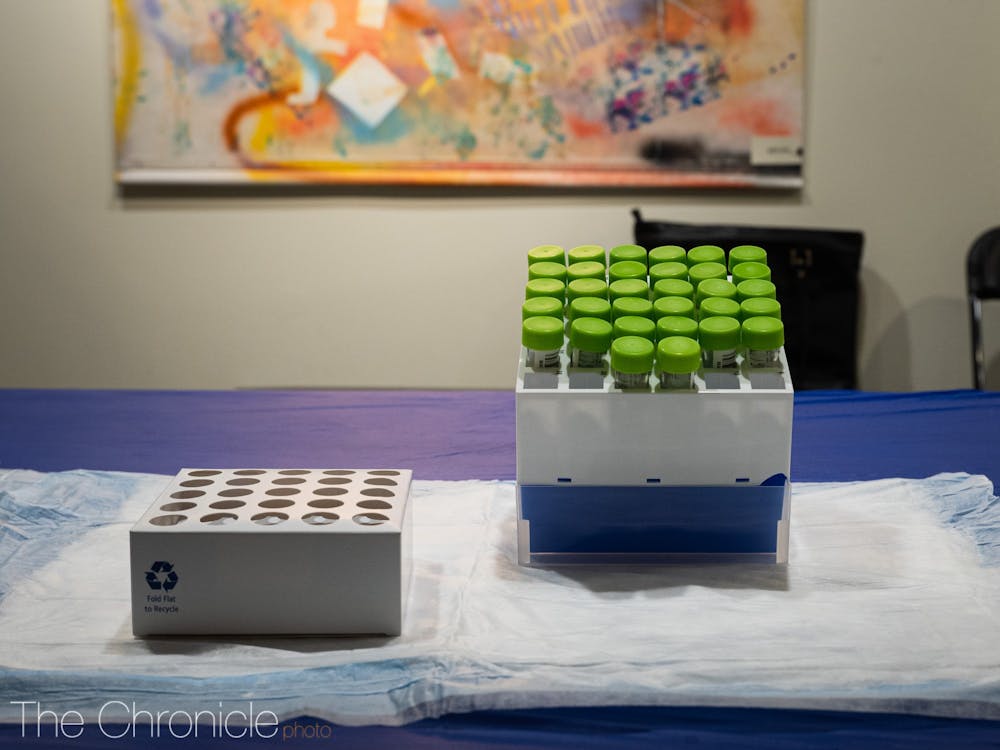It’s become common to wake up and see this text: "Duke United Testing: You have a required COVID test tomorrow. Visit a campus site to complete test. Details at…"
But how does Duke choose who gets tested and when?
According to Vice President for Administration Kyle Cavanaugh, students living on campus or in the Durham area are tested anywhere from once or twice a week to once every other week. In order to determine how many times each student gets tested, Duke uses “modeling data” that was developed by other universities, Cavanaugh wrote in an email.
These models are based on the prevalence of COVID-19 on and off campus, the percentage of asymptomatic infections and the average number of non-socially-distanced contacts, among other data, he explained.
Duke’s current surveillance testing system uses pool testing, a method of testing which combines respiratory samples from several people and screens them as a group for COVID-19. If the group sample comes back positive, the samples from each individual in the pool are then tested again.
This strategy is convenient for two reasons: The Duke community is a large population with a low prevalence of the virus, and pool testing allows Duke to save resources on testing. This process allows Duke to more efficiently screen for asymptomatic carriers of COVID-19.
Surveillance testing at Duke is not random, and is instead informed by prior testing results at the University.
“The whole idea is to try to adapt the strategy and the people we’re testing to what we’re seeing in the data,” said Tony Moody, an associate professor of pediatrics in the School of Medicine who is helping organize the pool testing system, in an August news release.
Administrators announced Aug. 13 that Duke would be conducting ongoing pool testing, beginning with undergraduates living on campus and expanding to other community members. Since then, Duke has aimed for about 10,000 tests per week, Cavanaugh wrote. Duke’s most recent testing update, which covered Sept. 26 to Oct. 2, reported 14,079 tests between students, faculty and staff.
Duke is also continuing its efforts to expand testing capacity, which partially explains why Duke students and faculty have been tested at varying rates.
"Whether and how frequently [students and faculty] are tested depends on the likelihood of their contact with non-socially distanced and asymptomatic individuals," Cavanaugh wrote.
For some, this short, self-administered test has become a part of their weekly routine.
Senior Kate Fogg, who lives off campus, usually gets tested once a week, she wrote. Occasionally, she’ll get tested twice. First-year Riya Mohan, who lives on campus, usually gets tested twice a week. Both go to testing locations on campus.
Both Fogg and Mohan are frequently on campus—so, according to Cavanaugh, they are tested more frequently than students who have no permission to be on campus and have online-only classes.
Students who are feeling sick are required to report their symptoms in the SymMon app or call Duke’s COVID-19 hotline to talk to a nurse. Although students who report symptoms are tested, their tests are administered individually. Similarly, the tests administered to students who are contact traced are not part of surveillance testing and are reported separately on the weekly testing tracker.
Student-athletes are individually screened and tested at frequencies depending on their sport, but their numbers are reported as part of the surveillance testing program. Athletes on the football, volleyball, women’s and men’s soccer and field hockey teams will be tested every day for the remainder of their seasons.
Faculty and staff are also pool tested at varying rates based on likelihood of contact with others, Cavanaugh wrote.
Between Sept. 26 and Oct. 2, the period for which Duke has reported data, the University reported 20 total COVID-19 positive tests, with 10 undergraduate cases, 5 graduate or professional student cases and 5 faculty and staff cases. Despite a low positivity rate—0.12% for students and 0.32% for faculty and staff—Duke has not slowed testing.
“Testing of asymptomatic individuals is clearly a key to successful early detection and mitigation of COVID in concentrations of populations like students, faculty and staff at a university,” Cavanaugh wrote.
As the semester progresses, testing will continue at the same rate or higher as Duke continues its efforts at preventing the spread of coronavirus on campus, he added.
Get The Chronicle straight to your inbox
Signup for our weekly newsletter. Cancel at any time.

